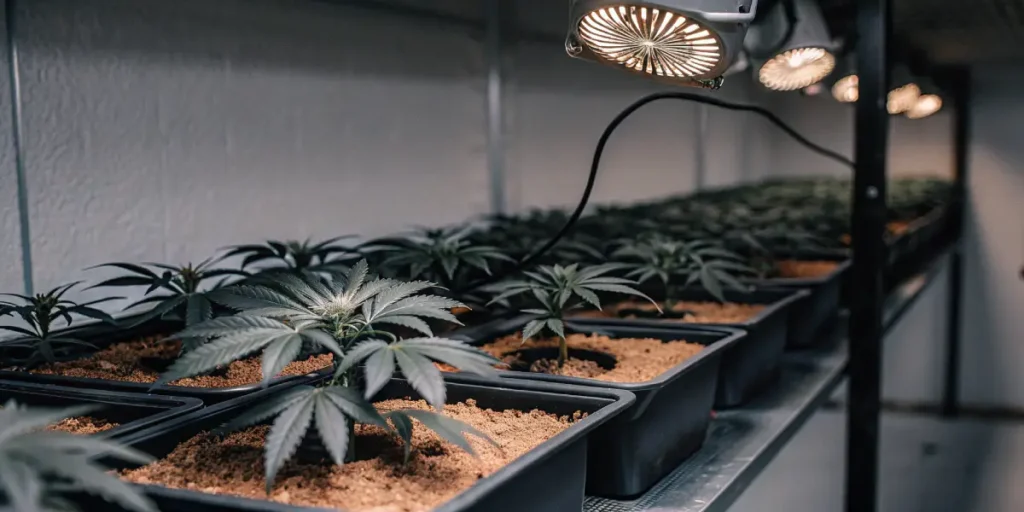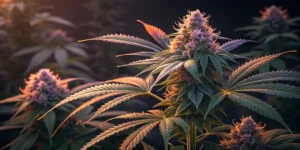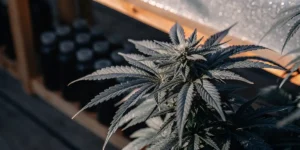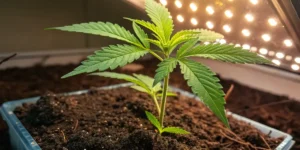Growing Sherbet Queen cannabis involves several key steps, as this strain is prized for its delicious flavor and potent effects. Known for its balanced indica-dominant genetics, Sherbet Queen is suitable for indoor and outdoor cultivation, appealing to both novice and seasoned growers. To begin, it is essential to choose a high-quality seed from a reputable source to ensure the best genetics which will yield a robust plant. Starting with the right seed sets the foundation for a successful grow.
The next step involves germination. Utilize the paper towel method by placing seeds between damp paper towels, keeping them warm and away from direct light. Once tappers appear—usually within 2 to 3 days—the seeds are ready for planting. Opt for a light, nutrient-rich soil blend or a coco coir medium to promote healthy root development. Transplant the germinated seeds carefully, maintaining a consistent environment with temperatures between 20-30°C and relative humidity around 65-70% during the seedling stage.
As the plants transition to the vegetative stage, they require ample light, ideally from full-spectrum LED grow lights if grown indoors. Maintain a light schedule of 18 hours on and 6 hours off. Regularly check pH levels to ensure they remain between 6.0 and 7.0, adjusting your water and nutrient solutions as necessary. During this stage, the plant’s structure can be managed through techniques such as low-stress training (LST) to encourage even canopy development and increase potential yield.
When ready, transition the Sherbet Queen plants to the flowering stage by adjusting the light cycle to 12 hours of light and 12 hours of darkness. This stage typically lasts about 8-9 weeks. It is crucial to gradually reduce humidity levels to around 40-50% to prevent mold and bud rot. During flowering, increase phosphorus and potassium levels while carefully monitoring the plants for signs of pests and nutrient deficiencies.
Finally, once the buds have reached peak maturity, usually indicated by milky trichomes and the desired amount of amber pistils, it’s time to harvest. Cut the branches, trim away excess leaves, and hang the buds to dry in a dark, well-ventilated area at around 18-24°C with 50% humidity. This drying period allows for the development of full flavor and potency. Once dried, cure the buds in airtight jars, opening them daily to burp excess moisture, thus ensuring the highest quality final product.
Sherbet Queen Strain Overview: Traits, Effects & Genetics
Sherbet Queen is an indica-dominant hybrid that stands out for its enticing attributes and delightful effects. This strain is a descendant of the renowned Girl Scout Cookies, known for its high-quality genetics. It typically features dense, resinous buds that are visually stunning with their vibrant orange pistils and frosty trichomes. Sherbet Queen showcases a profile rich in terpenes, offering a captivating medley of citrus, berry, and earthy flavors that make for a delectable smoking experience. This strain is moderately easy to cultivate, making it an appealing option for both novice and experienced growers.
The effects of Sherbet Queen are particularly cherished for their balanced yet deeply relaxing qualities. As an indica-leaning strain, it is celebrated for delivering a soothing euphoric high that comforts both the body and mind. Users report a tingling sensation that eases stress and tension, promoting a sense of calm and tranquility. The mental clarity provided by Sherbet Queen makes it suitable for evening use when unwinding after a long day, or for purely recreational purposes when one desires a blissful escape without being overly sedated. This strain is also popular among those seeking relief from chronic pain, anxiety, and insomnia.
Genetically, Sherbet Queen’s lineage can be traced back to the famous Girl Scout Cookies family, sharing its appealing characteristics and robust effects. The genetic makeup of Sherbet Queen blends these qualities with a unique terpene profile that sets it apart. The presence of caryophyllene, limonene, and myrcene contributes significantly to its aroma and therapeutic benefits. This genetic heritage endows Sherbet Queen with a reliable potency, often featuring THC levels that can reach up to 24%, ensuring a powerful yet enjoyable experience for cannabis enthusiasts. Whether for medicinal or recreational use, Sherbet Queen offers an exceptional representation of modern cannabis breeding.
Optimal Environment to Grow Sherbet Queen Successfully
Sherbet Queen is a standout strain among cannabis cultivators for its unique terpene profile and potent effects. To ensure this strain thrives, it’s essential to replicate its ideal growing environment. Sherbet Queen is well-suited for both indoor and outdoor cultivation, but it particularly excels in controlled, indoor conditions. These controlled environments enable growers to fine-tune temperature, humidity, and light conditions, which are crucial for the plant’s optimal growth and resin production. For indoor growing, growers should ensure their grow room or tent has a stable environment that replicates the plant’s preferred subtropical conditions.
The optimal temperature range for Sherbet Queen is between 20-26°C (68-79°F). During the day, maintaining the temperature at around 24°C (75°F) is ideal. At night, a slight drop of about 5°C (41°F) helps mimic natural outdoor conditions. Proper temperature management contributes significantly to the plant’s ability to photosynthesize efficiently, encouraging robust growth and maximizing yields. Using a thermostat in indoor grows can aid in maintaining this consistency, and providing adequate ventilation will ensure the air circulates properly, reducing the risk of mold and pests.
Humidity is another critical factor when cultivating Sherbet Queen. During the vegetative stage, a relative humidity of 60-70% encourages optimal growth. However, as the plant transitions to the flowering stage, the humidity should gradually be reduced to 40-50%. Lower humidity levels in the flowering phase reduce the risk of bud rot and encourage tighter, resinous buds. Utilizing a hygrometer to monitor humidity levels can be beneficial, coupled with the use of dehumidifiers or humidifiers as required.
Lighting plays a vital role in the development of Sherbet Queen, especially when grown indoors. During the vegetative phase, the plant requires 18 to 24 hours of light, while in the flowering stage, a 12/12 light cycle is recommended. High-intensity discharge lights or LEDs that provide a full spectrum are ideal, as these replicate the sun’s natural light more closely. Ensuring the plants receive sufficient light will enhance their photosynthetic capacity and contribute to more vigorous and productive growth.
Finally, soil quality and nutrition are paramount for growing Sherbet Queen. A rich, organic soil mix with good drainage capabilities will support healthy root development. Incorporating perlite can improve aeration and drainage. During growth, feeding the plants with balanced nutrients tailored to cannabis—specifically those higher in nitrogen during the vegetative phase, and higher in phosphorus and potassium during flowering—will support their overall development. Providing the right nutrient balance will not only encourage health but also enhance the strain’s terpene and cannabinoid profile.
Grow Room Setup for Sherbet Queen Plants
Sherbet Queen, an Indica-dominant strain known for its potent effects and stunning visual appeal, requires a carefully controlled grow room environment to thrive. When setting up a grow room for Sherbet Queen plants, it’s important to create a space that mimics the natural conditions this cannabis strain prefers. Key factors to consider include temperature, humidity, light, ventilation, and the grow medium. Each of these elements must be finely tuned to ensure healthy plant development and optimize yield potential.
Temperature is a critical component of the grow room setup. Sherbet Queen plants prefer a stable temperature, ideally within the range of 21 to 26 degrees Celsius (70-80 degrees Fahrenheit) during the day, and slightly cooler temperatures at night to simulate natural conditions. Consistent temperature aids in preventing stress and promoting optimal growth, making temperature control equipment like heaters or air conditioning an essential investment for your grow room. Monitoring devices should be installed to ensure stability.
Humidity levels should also meet the specific needs of Sherbet Queen plants. During the vegetative stage, maintain humidity around 60% to encourage robust leaf and stem growth. As the plants transition into the flowering stage, gradually reduce humidity to around 40-50% to prevent mold and mildew. This reduction mimics outdoor seasonal changes and promotes resin production, leading to more potent buds. Humidifiers and dehumidifiers can help achieve and regulate these ideal conditions.
Lighting is another crucial factor. Sherbet Queen thrives with high-intensity lighting systems, such as LED or HID lights, which simulate the full spectrum of sunlight. During the vegetative stage, provide approximately 18 hours of light to fuel growth, then switch to a 12-hour light cycle to initiate flowering. Light distance should be carefully managed to avoid burn and ensure even growth distribution. Adjust the lights as the plants grow to maintain optimal coverage and penetration.
Proper ventilation is vital for plant health, as it aids in temperature control and provides CO2, which is essential for photosynthesis. A well-designed grow room should include exhaust fans, intake vents, and oscillating fans to circulate air effectively. This setup prevents pest infestations and promotes oxygen exchange, allowing Sherbet Queen plants to utilize nutrients efficiently for vigorous growth and resin production.
Lastly, the choice of grow medium can influence the overall success of cultivating Sherbet Queen. While soil is a traditional option that offers a more forgiving buffer for nutrients, hydroponic systems can accelerate growth cycles and increase yield when managed correctly. Whatever medium you choose, ensure it supports root development and provides adequate drainage to prevent waterlogged conditions, which can be detrimental to plant health.
Indoor Growing Tips for Sherbet Queen
Sherbet Queen is a delightful indica-dominant strain that thrives in indoor growing environments. Known for its vigorous growth and stunning results, this strain brings exceptional quality and flavorful yields. To successfully cultivate Sherbet Queen indoors, growers should begin by ensuring optimal conditions for this strain, as it flourishes with attention to detail. One key aspect is maintaining a consistent temperature, ideally between 70-80°F (21-27°C), to mimic its preferred warm climate.
Lighting is another critical factor in cultivating Sherbet Queen indoors. This strain benefits from high-intensity lighting setups like LEDs or HID lamps during its vegetative and flowering stages. Implementing a light cycle of 18 hours on and 6 hours off during the vegetative stage, transitioning to 12 hours of light and 12 hours of darkness during flowering, can help maximize growth potential. Proper lighting ensures the plant’s robust and healthy development, contributing to dense, resinous flowers.
In terms of soil and nutrients, Sherbet Queen performs best in nutrient-rich, well-aerated environments. A high-quality soil mix containing perlite for aeration and water retention can support its growth effectively. Incorporating organic nutrients rich in nitrogen during the vegetative phase and increasing phosphorus and potassium during flowering will promote vigorous growth and significant flowering. Regular monitoring of pH levels, keeping them between 6.0 and 7.0, ensures root health and nutrient absorption.
Furthermore, humidity control is essential when growing Sherbet Queen indoors. During the vegetative phase, maintaining humidity levels between 40-60% will prevent mold while promoting healthy transpiration. As the plant transitions into the flowering phase, reducing humidity to around 40-50% is crucial to prevent bud rot and mold, preventing potential damage to developing buds. Implementing oscillating fans can provide adequate airflow, ensuring a healthy growing environment.
Lastly, regular pruning and training can help optimize indoor growth. Techniques like topping and low-stress training (LST) can increase light penetration and air circulation, leading to an even canopy and boosted yields. By carefully monitoring and adjusting these indoor growing tips, cultivators can enjoy the vibrant, fruity flavors and calming effects of a well-grown Sherbet Queen harvest.
Outdoor Growing Tips for Sherbet Queen
Sherbet Queen is a remarkable strain that thrives beautifully in outdoor environments. To ensure a successful outdoor cultivation of Sherbet Queen, it’s important to recognize its specific growth requirements and adapt to the external conditions accordingly. First, selecting the right geographical location is crucial. This strain is known for its resilience, but it particularly flourishes in warm climates with plenty of sunlight. Make sure to plant your Sherbet Queen during a period when the threat of frost has passed as this strain prefers a consistent and mild temperature to reach its full potential.
When preparing your outdoor setup, ensure that your Sherbet Queen plants receive ample sunlight, ideally 8 hours a day or more, to enhance photosynthesis and maximize their growth potential. Choose a well-drained soil enriched with organic matter to foster root development and provide the nutrients essential for healthy growth. Regularly monitor the pH value of the soil; maintaining it around 6.0 to 6.8 is ideal for optimizing nutrient absorption and ensuring your plants thrive. Consider using compost or organic fertilizers to support their growth and boost the overall yield.
Watering strategies are crucial in cultivating Sherbet Queen outdoors. While regular watering is necessary, overwatering can lead to root rot and other fungal problems. It’s recommended to let the soil slightly dry out between waterings to avoid drowning the roots. Implementing proper pest management strategies is also key as outdoor plants are more susceptible to pests such as aphids and spider mites. Natural predators like ladybugs or neem oil sprays can be effective organic options to keep pests at bay, ensuring your Sherbet Queen plants remain healthy and robust.
Pruning is another vital technique to optimize the yield and air circulation around Sherbet Queen plants. By removing the lower branches and unnecessary leaves, you allow the plant to focus its energy on the main colas and improve sunlight penetration. This practice not only encourages bigger and denser buds but also reduces the chance of mold development, especially in humid outdoor conditions. Lastly, paying attention to your plant’s flowering period, which usually starts in late summer to early autumn, can guide you in planning the harvest time, ensuring the buds are picked at their peak for maximum potency and flavor.
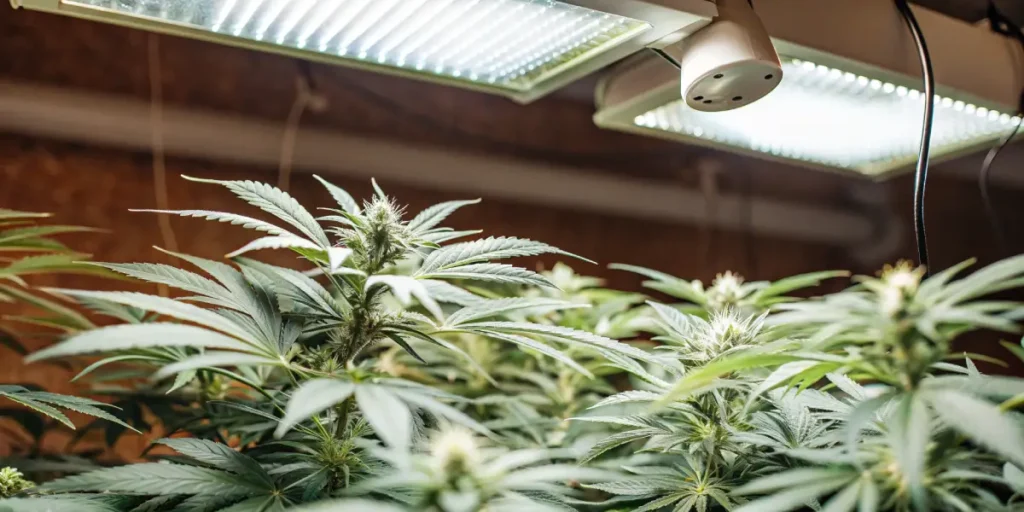
How to Germinate & Propagate Sherbet Queen
The process of germinating Sherbet Queen cannabis seeds is the vital first step in cultivating this lush and aromatic strain. Sherbet Queen, prized for its delectable flavors and balanced effects, requires proper care right from the start to ensure a successful growth cycle. Begin with high-quality seeds to improve your chances of successful germination. One popular method is the paper towel technique, which offers an ideal environment for seeds to sprout.
To employ the paper towel method, gather two clean paper towels and moisten them with distilled water. Take care to have them damp but not soaked. Place a few seeds between the layers of the paper towels, ensuring each seed has enough space for the root to emerge unobstructed. Once arranged, cover the seeds with the remaining paper towel layer, then place the sandwich in a plastic bag or a shallow container with a lid to maintain a humid environment. Store the setup in a warm, dark area, such as a cupboard, at a temperature between 70-85°F (21-29°C).
Check the seeds daily to monitor progress and ensure the towels remain moist. Typically, Sherbet Queen seeds will begin to germinate within 24 to 72 hours, with a small taproot emerging from each seed. Once the taproot is approximately 0.5-1 inch long, carefully transfer the sprouted seeds into a growing medium, such as soil or a peat pellet, ensuring the taproot is facing downward. This careful handling will help establish a strong foundation for future growth.
Propagation of Sherbet Queen can also involve cloning, which allows you to create genetic replicas of a robust mother plant. To clone, select a healthy branch from a mature Sherbet Queen plant and make a clean, diagonal cut. Dip the cut end in rooting hormone before planting it into a medium, such as rockwool or soil, to encourage root development. Maintaining high humidity and moderate temperatures will promote successful rooting.
By mastering these germination and propagation techniques, cultivators can maximize their chances of growing vigorous and high-yielding Sherbet Queen plants. Combining careful attention to detail with patience will ultimately lead to a rewarding harvest of this delightful cannabis strain.
Vegetative Stage
The vegetative stage is a crucial period in the lifecycle of your Sherbet Queen plants. During this stage, your plants will focus on growing larger and stronger, developing a robust structure that can support an abundant yield when flowering. To achieve the best results, it’s vital to maintain an optimal environment and adhere to key cultivation practices. Begin by ensuring that your plants receive adequate light. Sherbet Queen thrives under a consistent light cycle, typically 18 hours of light and 6 hours of darkness each day, using high-quality grow lights like LEDs or HIDs.
Watering is another critical aspect of nurturing Sherbet Queen plants during their vegetative stage. It’s essential to strike a balance between over-watering and under-watering, as both can stunt growth and lead to various plant health issues. Allow the top inch of soil to dry out before watering again, ensuring proper drainage to prevent root rot. Additionally, maintaining humidity levels between 55-70% can support healthy leaf and stem development. Keep an oscillating fan running to promote air circulation, which helps strengthen stems and reduces the risk of mold and pests.
Feeding your Sherbet Queen plants with the appropriate nutrients is key to vigorous growth during the vegetative stage. Utilize a nutrient-rich fertilizer with a higher nitrogen content to facilitate lush, green foliage. Be mindful of nutrient levels, as cannabis plants are sensitive to nutrient burn. Begin with half-strength nutrients, gradually increasing as the plants show signs of healthy growth. Regular pH checks of your soil and water, aiming for a level between 6.0 and 7.0, will ensure that your plants can absorb nutrients efficiently. Monitoring these variables closely can set your Sherbet Queen plants on the path to a successful flowering phase.
Pruning and training your Sherbet Queen plants can further enhance growth during their vegetative phase. Techniques such as topping, fimming, and low-stress training (LST) encourage bushier plants and maximizing light exposure to lower branches. By carefully implementing these strategies, you can improve light penetration and airflow, ultimately leading to a higher yield. Regularly remove yellowing leaves and inspect for signs of pests or diseases. With attentive care and maintenance, your Sherbet Queen plants will be well-prepared to transition into the flowering stage and produce bountiful, high-quality buds.
Flowering: What to Expect
When cultivating Sherbet Queen, one of the most highly sought-after cannabis strains, growers can anticipate a visually stunning and aromatic flowering phase. This strain, renowned for its vibrant colors and rich terpene profile, typically begins its flowering period around eight to nine weeks after entering the 12/12 light cycle. During this time, the plants develop robust, densely packed colas that are a sight to behold, featuring a mesmerizing blend of deep purple, bright orange, and lime green hues.
As the flowering stage progresses, the aromatic profile of Sherbet Queen intensifies, enveloping the grow room in a delightful fusion of sweet, citrusy, and earthy scents. This olfactory experience is largely attributed to the strain’s high concentration of terpenes such as limonene and myrcene, which not only contribute to its characteristic fragrance but also enhance its overall effects. Growers should ensure adequate ventilation and air circulation within the cultivation space to manage and disperse these potent aromas effectively.
Sherbet Queen is known for producing a generous yield, especially when grown under optimal conditions. Indoor growers can expect to harvest approximately 450-500 grams per square meter, while outdoor cultivators might see yields of up to 500-550 grams per plant. To maximize yield, it is crucial to maintain an appropriate environment throughout the flowering phase, paying particular attention to temperature, humidity, and lighting. Keeping temperatures within the range of 20-26°C and maintaining humidity at around 40-50% are essential for promoting healthy bud development and preventing mold growth.
In the final stages of flowering, it is vital to monitor the trichomes closely to determine the ideal harvest time. Sherbet Queen’s trichomes transition from clear to milky white, and finally, to a hint of amber as it reaches peak potency. Harvesting when most trichomes are milky with a small percentage turning amber ensures that the resulting buds will offer a well-balanced effect, characterized by a relaxing yet uplifting high that Sherbet Queen is celebrated for. By paying close attention during this crucial phase, growers can ensure a bountiful and rewarding harvest.
Fertilizers & Nutrient Schedule
Cultivating Sherbet Queen, a delightful indica-dominant hybrid, can be a rewarding venture with its mesmerizing aroma and potent effects. To ensure that your Sherbet Queen plants reach their full potential, a focused approach to feeding is essential. The nutritional needs of this strain revolve around a balanced supply of macronutrients and micronutrients. Macronutrients, including nitrogen, phosphorus, and potassium, are fundamental during the cannabis plant’s growing cycle. Each growth stage demands a shift in nutrient ratios, requiring growers to tailor their feeding strategies accordingly.
During the vegetative stage, Sherbet Queen thrives on a diet rich in nitrogen, which promotes vigorous growth and lush, green foliage. Implementing a balanced grow fertilizer with a higher nitrogen concentration can support this phase effectively. A common nutrient ratio for the vegetative stage might be 3:1:2 (N:P:K), ensuring the plant has the necessary components to develop a robust structure. Consistent monitoring is crucial, as nutrient deficiencies can impede growth. If yellowing of the leaves or stunted growth is observed, it may indicate a nitrogen deficiency, which can be rectified with a higher dosage of nitrogen-based fertilizers.
As the plants transition into the flowering stage, the nutritional focus should shift towards increased phosphorus and potassium levels. These nutrients support bud development, enhancing both size and resin production. A recommended nutrient ratio for the flowering stage may be 1:3:2 (N:P:K). Careful adjustment of nutrient levels as the plant progresses ensures optimal flower production, while excess nitrogen at this stage could hinder bud formation. Regular flushing with pH-balanced water helps prevent nutrient lockout and keeps the soil environment healthy, facilitating better nutrient uptake.
In addition to macronutrients, micronutrients such as calcium, magnesium, and sulfur also play pivotal roles in the healthy development of Sherbet Queen. Calcium supports cell wall development, magnesium is vital for photosynthesis, and sulfur is involved in amino acid production. Integrating a cannabis-specific micronutrient supplement or using an all-in-one fertilizer designed for cannabis can mitigate potential deficiencies. Observing plant health and growth patterns can reveal micronutrient imbalances, allowing growers to make timely adjustments.
Scheduling nutrient applications for Sherbet Queen involves following a precise regimen, often based on a weekly schedule. Many growers adhere to a structured feed-water-feed pattern, allowing the plants to benefit from nutrient uptake while preventing over-fertilization. Adjustments may be necessary based on environmental factors or specific plant responses. Regular monitoring of pH levels in both the water source and soil ensures optimal nutrient availability. In essence, a proactive and informed approach to feeding Sherbet Queen can lead to a bountiful harvest, characterized by aromatic, potent buds.
Pest and Disease Prevention for Healthy Cannabis Plants
Sherbet Queen, a strain appreciated for its unique profile and vibrant growth, requires diligent pest and disease prevention methods to thrive. Maintaining a healthy growing environment is crucial for fending off common cannabis pests such as spider mites, aphids, and whiteflies. Start by incorporating a comprehensive sanitation routine. Regularly clean your growing area and tools, as pests and diseases can easily spread through unclean environments. Removing debris and decaying plant matter minimizes the chances of providing these nuisances a home and breeding ground.
Beyond cleanliness, employing organic preventive measures is highly effective for maintaining Sherbet Queen’s vitality. Introducing beneficial insects like ladybugs or predatory mites can naturally reduce pest populations without damaging your plants. Additionally, neem oil is widely regarded as a non-toxic option for keeping potential pests at bay. Spraying neem oil solutions on the foliage serves not only as a deterrent but also as a defensive measure against fungal infections, which could otherwise thwart the plant’s growth and yield.
The control of environmental conditions is another foundational factor in preventing pest and disease outbreaks. Ensure optimal humidity and temperature levels, as fluctuating conditions can stress plants, making them more susceptible to ailments. Use fans and ventilation systems to regulate air circulation, preventing the development of mold and powdery mildew, which thrive in stagnant and moist environments. Moreover, monitoring soil health is critical to discouraging harmful fungi and pathogens; incorporating well-aerated, well-draining soil mixes can effectively mitigate these threats.
Regular inspections should be a non-negotiable part of your growing protocol. Thoroughly examine your Sherbet Queen plants for early signs of distress or abnormalities. Yellowing leaves, wilting, or unexplained speckling can indicate underlying pest issues or diseases. By identifying problems early, corrective action can be taken before they escalate, thereby safeguarding your crop. This proactive approach, combined with the outlined preventive measures, greatly enhances the likelihood of a bountiful and healthy harvest of Sherbet Queen cannabis.
Harvesting & Drying Sherbet Queen the Right Way
Harvesting Sherbet Queen at the optimal time is crucial for maximizing its flavor, potency, and yield. Typically, Sherbet Queen is ready for harvest around eight to nine weeks of flowering. It’s essential to monitor the trichomes closely; they should transition from clear to a milky white with some turning amber. This indicates the peak THC levels. Use a magnifying glass or a jeweler’s loupe to get a close look at the trichomes, ensuring you harvest at the correct time for the desired effects. Carefully cutting the stems is essential to minimize any damage to the plant.
Once harvested, the drying process begins. This is a critical step in preserving the bud’s quality. Find a space that’s dry, cool, and dark to hang your Sherbet Queen. It’s vital to maintain a temperature of around 18-24°C (65-75°F) with a humidity level of 45-55%. These conditions prevent mold growth and ensure the buds dry evenly. Remove large fan leaves but keep smaller sugar leaves intact until the final manicure. Hang the branches upside down, allowing them to dry slowly over a period of 7-10 days. Proper air circulation is paramount; consider using a small fan to gently move air around the room.
When the stems snap instead of bending, it indicates that the Sherbet Queen is adequately dried and ready for the next stage: curing. This next step, curing, enriches the flavors, enhances the aroma, and increases the overall smoothness of the smoke. Ensure you trim the remaining sugar leaves and store the buds in airtight glass jars. Open the jars daily for about 15-30 minutes to let fresh air circulate, gradually reducing this burping process over the next few weeks. Proper curing of Sherbet Queen takes patience, but the end result is a premium product with unmatched quality and potency.
Taking the time to harvest and dry Sherbet Queen correctly can significantly enhance your cannabis experience. Rushing the process might lead to lesser-quality products, undermining the potential this strain has to offer. Invest attention into these critical steps and relish in the rewards of a stellar harvest yielding aromatic, potent, and flavorful buds that reflect the efforts put into its cultivation.
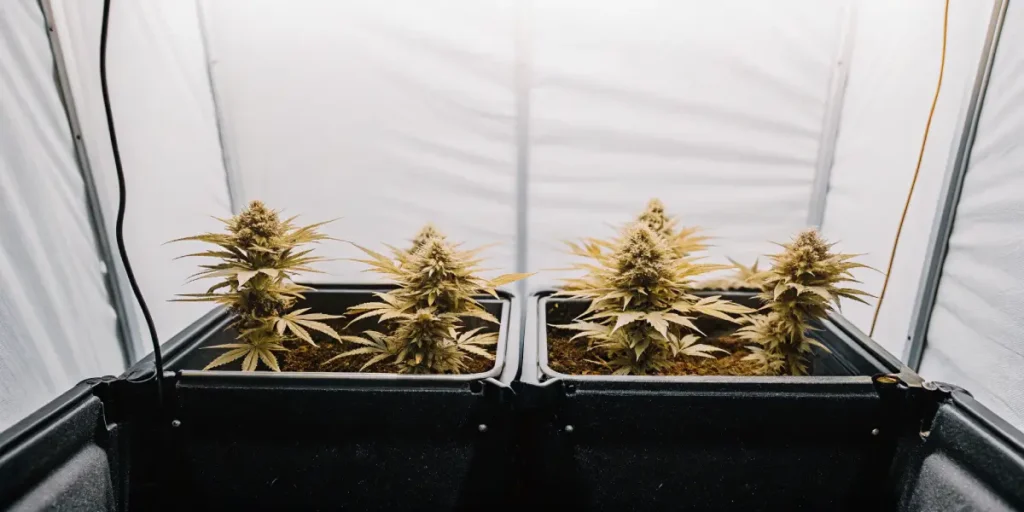
Sherbet Queen Strain Type: Indica, Sativa or Hybrid?
The Sherbet Queen strain is classified as an indica-dominant hybrid, a testament to its rich and diverse genetic heritage. This strain is renowned for its deeply calming effects, which are primarily attributed to its indica lineage. Indica strains are known for their potent relaxing qualities and ability to provide stress relief, and Sherbet Queen embodies these traits while also offering a hint of the euphoria typically associated with sativas. This hybrid balance makes it a popular choice for individuals seeking both physical relaxation and a mild cerebral uplift, perfect for unwinding after a long day.
Sherbet Queen’s indica dominance is largely evident in its physical characteristics and growing traits. This strain tends to have a short, bushy stature with broad leaves, common among indica varieties. These traits are advantageous for growers with limited space, as the compact size of the plants allows for more efficient use of grow areas. Despite its modest height, Sherbet Queen is known to produce generous yields, making it a favorite among cultivators who seek both quality and quantity. The indica influence not only contributes to its growth patterns but also to its resilience and adaptability, making it suitable for various growing environments.
While the indica traits of Sherbet Queen are prominent, the hybrid nature of this strain brings forth an intriguing complexity in its effects. The sativa genetics impart a subtle but present mental stimulation, providing users with a gentle creative boost and enhanced focus without overwhelming the senses. This balance ensures that Sherbet Queen is not excessively sedative, thus appealing to users who appreciate the calming attributes of an indica but also desire a touch of mental clarity. Whether for medical use or recreational enjoyment, the nuanced effects of this hybrid make it a versatile choice suitable for various needs and preferences.
Why Grow Sherbet Queen? Key Benefits for Cultivators
Sherbet Queen is a highly coveted strain among cannabis cultivators due to a combination of its vibrant lineage, ease of growth, and potent effects. Originating from the iconic Girl Scout Cookies lineage, Sherbet Queen boasts an impressive genetic heritage that promises high-quality buds. This strain is predominantly indica, making it highly resistant to environmental stress and suitable for both novice and experienced growers. Its resilience against pests and molds also contributes to its reputation as an ideal plant for cultivation, ensuring that you can achieve a bountiful harvest with minimal fuss.
One of the standout attributes of Sherbet Queen is its remarkable yield potential. When grown indoors, the strain can produce up to 500 grams per square meter, while outdoor cultivation can yield approximately 450-500 grams per plant. The compact size of Sherbet Queen, typically reaching up to 80-120 cm in height, makes it especially suitable for indoor setups or constrained spaces. This makes it easier for cultivators to manage and maintain, particularly in home-grow environments. Additionally, the strain flowers within a relatively short time frame, typically 7-9 weeks, offering a quick turnaround from planting to harvesting.
The aromatic profile of Sherbet Queen is another compelling reason for cultivators to opt for this strain. It exudes a delightful blend of sweet, citrus, and earthy notes, which not only appeal to those consuming the buds but also add a pleasant olfactory sensation to the growing environment. Beyond its aromatic allure, Sherbet Queen offers rich, relaxing effects owing to its THC content, which generally ranges between 20-24%. This makes it a preferred choice for consumers seeking therapeutic benefits, such as stress relief and muscle relaxation, further enhancing its market demand and profitability for cultivators.
In short, growing Sherbet Queen serves as a rewarding endeavor for cultivators due to its robust genetics, ease of growth, impressive yields, and potent effects. Its appealing flavor and aroma profiles additionally make it a favorite among cannabis connoisseurs, ensuring that crops will be both enjoyable to cultivate and highly sought after in the market. Whether you are just starting out or are an experienced grower, Sherbet Queen represents a reliable and satisfying choice for your next cannabis cultivation project.
Potential Challenges When Growing Sherbet Queen
Sherbet Queen is a popular strain due to its alluring flavors and potent effects; however, cultivating this strain can present several challenges to growers. First, one of the primary concerns when growing Sherbet Queen is maintaining the ideal temperature and humidity levels. This strain thrives in a Mediterranean-like climate, which means growers must carefully regulate the environment, keeping temperatures within the range of 20-26°C (68-79°F) and relative humidity levels around 40-50% during the flowering stage. Deviations from these conditions can lead to stress on the plants, impacting their growth and yield.
Pest control is another potential challenge when cultivating Sherbet Queen. Like many cannabis strains, Sherbet Queen can be susceptible to common pests such as spider mites, aphids, and whiteflies. These pests can cause significant damage by feeding on plant tissues and spreading diseases. Regular inspection of the plants and maintaining a clean growing environment can help mitigate these risks. Implementing organic pest control methods, such as introducing beneficial insects or using neem oil, can also be effective in managing pest populations.
Nutrient management is crucial when growing Sherbet Queen, as this strain has specific nutritional requirements. Over-fertilization can cause nutrient burn, leading to discolored leaves and stunted growth, while nutrient deficiencies can cause yellowing leaves and poor bud development. Growers must carefully monitor the nutrient intake and adjust levels of primary nutrients such as nitrogen, phosphorus, and potassium, as well as secondary nutrients and micronutrients, to ensure optimal plant health. Conducting regular soil tests and observing changes in plant appearance can provide early warnings of potential nutrient issues.
Additionally, Sherbet Queen can be a finicky strain regarding pruning and training techniques. This strain tends to grow bushy, necessitating regular pruning to ensure adequate light penetration to lower leaves and buds. Inexperienced growers may struggle to strike the right balance between promoting healthy growth and avoiding excessive stress on the plants. Techniques such as topping, low-stress training (LST), and defoliation must be used judiciously to maximize yields without causing unnecessary harm to the plants.
Is Sherbet Queen Worth Buying? Here’s What You Need to Know
The cannabis strain known as Sherbet Queen is gaining popularity among both novice and advanced growers for its unique blend of appealing characteristics. Originating from the genetics of Pink Panties and Sunset Sherbet, this indica-dominant strain not only captivates with its intriguing lineage but also with its striking blend of flavors and effects. Understanding the potential value and appeal of Sherbet Queen is essential for any cultivator considering adding this strain to their growing catalog. From its remarkable growth traits to its rich sensory profile, there are multiple factors to evaluate.
Sherbet Queen is particularly celebrated for its robust growth cycle and resilience, making it a wise investment for growers seeking reliable yields. Generally easy to cultivate, this strain adapts well to both indoor and outdoor environments. When grown under optimal conditions, Sherbet Queen produces enticingly high yields of dense, resin-coated buds. Its resistance to common pests and molds further enhances its appeal, reducing the potential for significant losses and the need for constant monitoring. With a flowering period of around 7 to 9 weeks, it offers the added benefit of a relatively quick harvest time.
The sensory experience offered by Sherbet Queen also contributes significantly to its desirability. The buds release a sweet, citrusy aroma accented by earthy undertones, making it a delight for the senses. Upon consumption, users often report a rich, creamy flavor palette combining sweet berry and skunky citrus notes. The effects are predominantly relaxing, providing a calming, euphoric high that is ideal for stress relief and unwinding. Due to its moderate THC levels, it offers a balanced high that is potent yet manageable, suitable for various user preferences.
In short, Sherbet Queen is a worthy consideration for anyone interested in growing or consuming cannabis. Its combination of ease of cultivation, robust yields, alluring flavors, and balanced effects make it a standout in the crowded landscape of cannabis strains. Whether you are a home grower looking to try something new or a seasoned cultivator aiming for reliable strains, Sherbet Queen might be what you’re seeking. Investing in this strain could enrich your cannabis experience both in terms of cultivation and consumption.
FAQs about Sherbet Queen
What is Sherbet Queen, and where does it originate from?
Sherbet Queen is a popular cannabis strain that is known for its sweet, dessert-like aroma reminiscent of fruit and candy. It generally originates from hybrid strains, combining the best qualities of its parent types to produce a balanced experience. Sherbet Queen offers a unique blend of relaxation and euphoria, making it a favorite among recreational users. Its origins can often be traced back to diverse strains like Girl Scout Cookies and Pink Panties, known for their potent effects and sweet, aromatic profiles.
What are the primary effects of consuming Sherbet Queen?
Consuming Sherbet Queen typically results in a well-balanced blend of relaxation and upliftment. Users often report feeling a rush of happiness and creativity, followed by a relaxing effect that calms the body but doesn’t overly sedate. It’s especially favored for those looking to alleviate stress, anxiety, and mild pain without the heavy lethargy associated with other more potent indica strains. This makes it versatile for daytime and evening use.
What does Sherbet Queen taste and smell like?
Sherbet Queen is celebrated for its deliciously sweet aroma and flavor, which can remind one of a fruit sorbet or sugary pastry. Its scent profile includes hints of berries, citrus, and tropical fruits which translate into a similar taste when consumed. Many users also note an undertone of earthy or nutty flavors, providing a complex and enjoyable experience for the palate. This dessert-like aroma and flavor make it particularly appealing to new and seasoned cannabis connoisseurs alike.
What are the medicinal benefits of Sherbet Queen?
Sherbet Queen offers various medicinal benefits, commonly used to manage stress, anxiety, and depression due to its uplifting effects. Its calming properties can also be beneficial for mild to moderate pain relief, making it useful for managing chronic pain conditions like arthritis or headaches. Some users find it helpful for stimulating appetite and combating nausea, further broadening its applications in medical cannabis use. However, it’s essential to consult with a healthcare provider for personalized advice.
Are there any notable side effects when using Sherbet Queen?
Like many cannabis strains, Sherbet Queen can have side effects, although they are generally mild. The most commonly reported side effects include dry mouth and dry eyes, which can usually be managed with hydration and eye drops. Some users may also experience mild dizziness, anxiety, or paranoia, especially with higher doses. It’s crucial for individuals to start with small doses to gauge their tolerance and response to the strain, particularly if they are new to cannabis.

